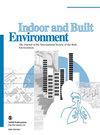Evaluating the dynamic thermal sensitivities of human body with high-dense contacting thermal stimuli
IF 2.9
3区 工程技术
Q2 CONSTRUCTION & BUILDING TECHNOLOGY
引用次数: 0
Abstract
Existing research have explored thermal sensitivity under steady thermal conditions while how it changes with time is unknown. In this study, the arm and face were taken as examples to study dynamic characteristics of thermal sensitivity. The test spots were stimulated under thermally neutral ambient conditions to obtain skin temperature and thermal sensation at three levels (e.g. the micro-scale (1.54 cm 2 ) spot, local body part and whole body) at intervals of 4 s. Results showed that in the first 4 s of stimuli, skin temperature change would reach 52% of the final variation. The overshooting rate of the arm thermal sensitivity was 1.6 and 1.8 times over the stable state for cooling and heating stimuli, and that of the face was 1.9 and 2.0 times. 95% of subjects on the arm and 85% on the face were more sensitive to cooling stimuli. The warmth sensitivities of different genders and body parts were shown to be significantly different, while the cold sensitivity of different body parts produced small differences. When stimulating one test spot, the ratio of thermal sensation at three levels was 15:4:1 on the arm and 16:3:1 on the face. These results can help to understand how the body responds to spatially ununiform and temporally unsteady thermal exposures.高密度接触热刺激下人体动态热敏度的评价
现有的研究已经探索了稳定热条件下的热敏性,但它如何随时间变化是未知的。本研究以手臂和面部为例,研究热敏性的动态特性。在热中性环境条件下刺激测试点,获得三个层次(如微尺度(1.54 cm 2)点,局部身体部分和全身)的皮肤温度和热感觉,间隔4 s。结果表明,在刺激的前4 s,皮肤温度变化可达到最终变化的52%。在冷却和加热刺激下,手臂热敏度的超调率分别是稳态的1.6倍和1.8倍,面部热敏度的超调率分别是1.9倍和2.0倍。95%的手臂实验对象和85%的面部实验对象对冷却刺激更敏感。不同性别、不同身体部位对温暖的敏感性差异显著,而不同身体部位对冷的敏感性差异较小。当刺激一个测试点时,三个层次的热感觉比在手臂上为15:4:1,在脸上为16:3:1。这些结果有助于了解人体对空间不均匀和时间不稳定的热暴露的反应。
本文章由计算机程序翻译,如有差异,请以英文原文为准。
求助全文
约1分钟内获得全文
求助全文
来源期刊

Indoor and Built Environment
环境科学-工程:环境
CiteScore
6.40
自引率
25.00%
发文量
130
审稿时长
2.6 months
期刊介绍:
Indoor and Built Environment publishes reports on any topic pertaining to the quality of the indoor and built environment, and how these might effect the health, performance, efficiency and comfort of persons living or working there. Topics range from urban infrastructure, design of buildings, and materials used to laboratory studies including building airflow simulations and health effects. This journal is a member of the Committee on Publication Ethics (COPE).
 求助内容:
求助内容: 应助结果提醒方式:
应助结果提醒方式:


